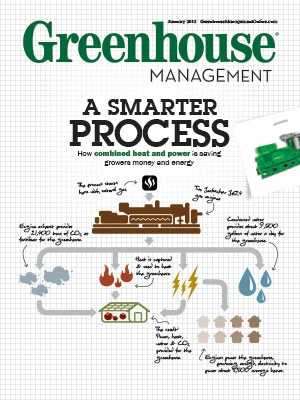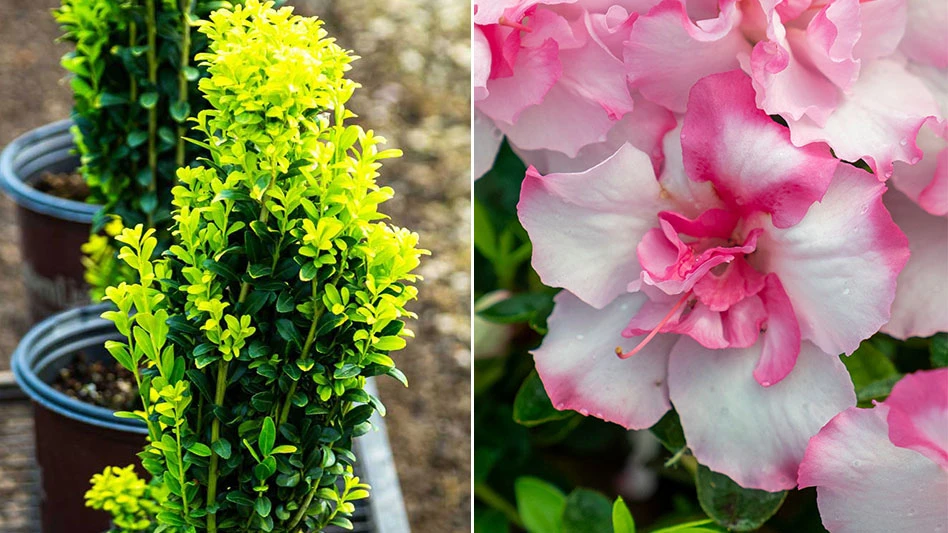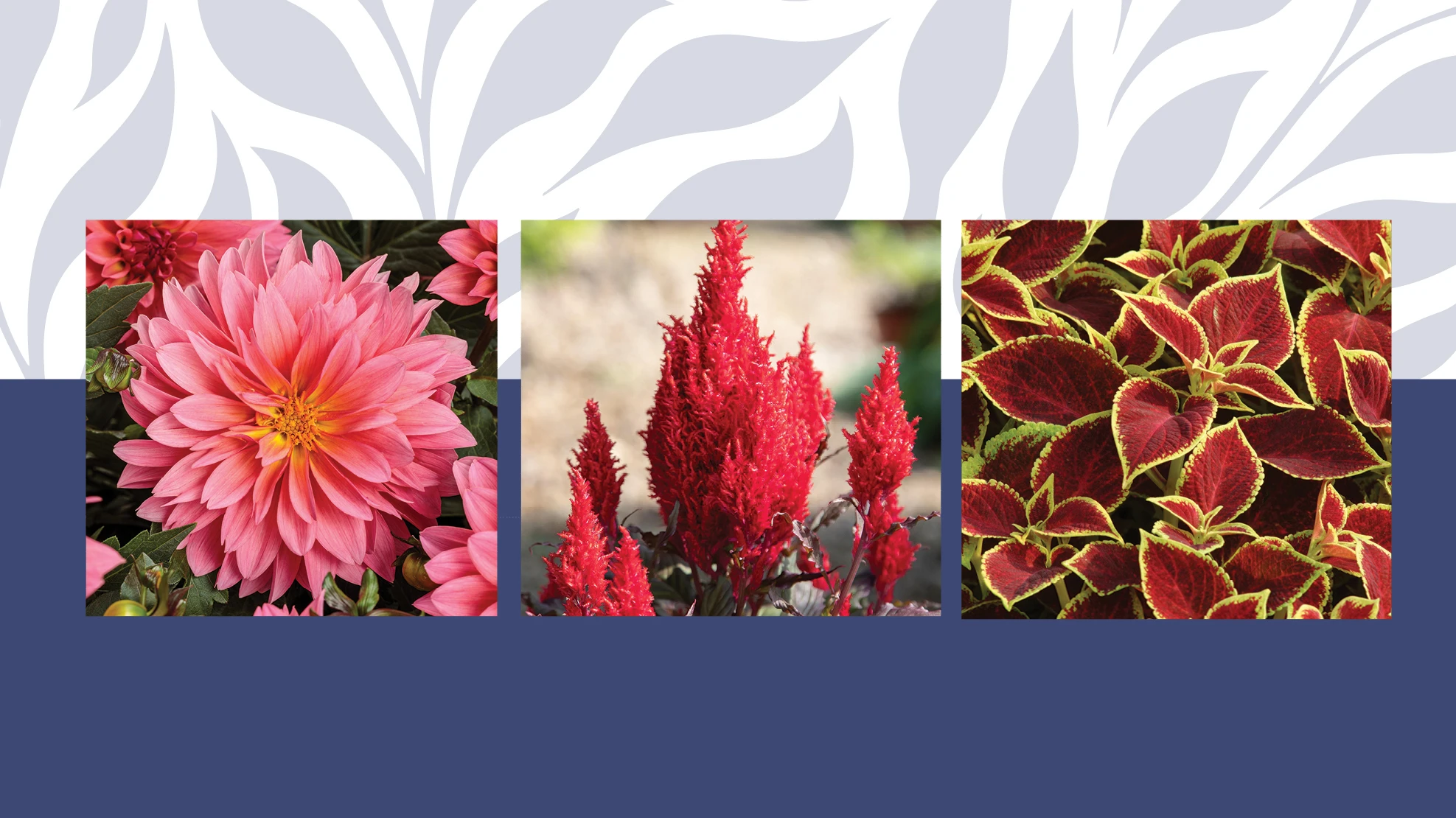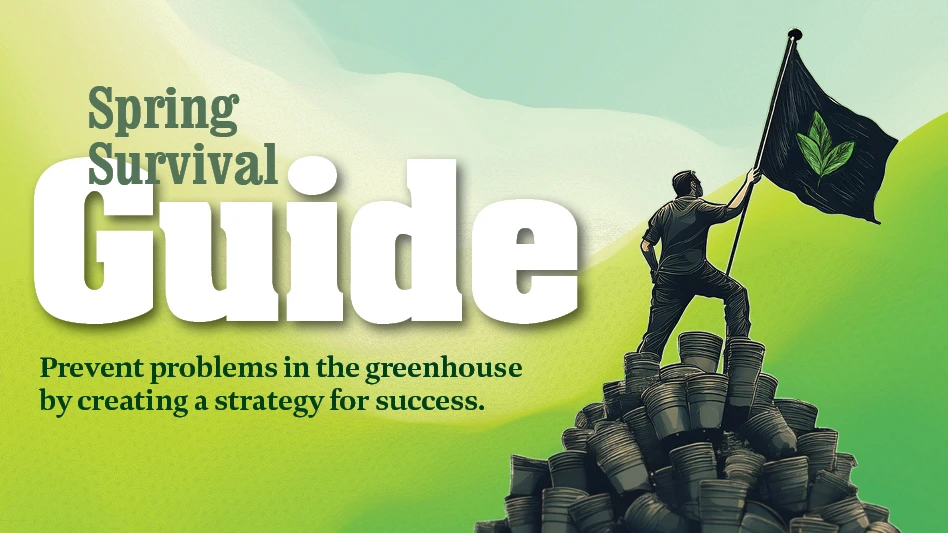 ETHYLENE (C2H4) is a gas that is produced by plants as a byproduct of incomplete combustion. Ethylene is both a useful plant growth regulator and a harmful contaminant in greenhouses.
ETHYLENE (C2H4) is a gas that is produced by plants as a byproduct of incomplete combustion. Ethylene is both a useful plant growth regulator and a harmful contaminant in greenhouses.
During production, plants may be exposed to low levels — 25 to 200 parts per billion (ppb) — of ethylene for weeks or even months. The source of ethylene is usually an improperly vented or malfunctioning heater, and the result is malformed or stunted growth and flowering delays that may make a crop unmarketable. In these instances, ethylene damage can be very hard to distinguish from nutritional disorders or disease problems. Ethylene damage following production can be more extreme and symptoms can appear very quickly.
During packaging, shipping and retailing, plants are more likely to be exposed to higher concentrations — 1 part per million (ppm) or more — of ethylene for shorter periods of time, from a few hours to a few days.
The keys to preventing postproduction ethylene damage are to reduce ethylene production by the plant, prevent exposure to external sources of ethylene, and protect the plant from ethylene (both external and internal). Ethylene management strategies must be part of the proper postproduction care and handling of greenhouse crops, especially during shipping.
 Preventing ethylene exposure and reducing ethylene production from plants
Preventing ethylene exposure and reducing ethylene production from plants
Plants must be handled carefully during packaging and shipping to avoid mechanical damage. Wounded plants can produce significant levels of ethylene. Sleeving plants can also cause wounding. Make sure that the sleeving material has holes that allow the ethylene gas to diffuse away from the plant, otherwise the microclimate around the sleeved plant can quickly accumulate damaging levels of ethylene (Figure 1). Sleeve plants just before they are being shipped and remove the sleeves as soon as possible. Open carts are a great way to transport your finished crop because they’re an efficient way to move plants without damage, and they allow for air flow around the plants within the truck (Figure 2). Use electric pull-carts to transport the plants from the production area to the loading dock. If you put shrink wrap around the carts to keep plants in place, this can also create a microclimate with high relative humidity and high ethylene levels. Minimize the time that plants are on these carts and make sure that the plants are held in place by the wrap, but not completely sealed in. Deadheading flowers and removing dying leaves makes the crop more attractive, but it also removes potential sources of ethylene. Additionally, Botrytis and other fungi that degrade dying plant material produce their own ethylene.

Package and sort orders in a well-ventilated loading dock area that is free of sources of ethylene. If possible, load trucks in the early morning hours when it is cooler. Plants not only produce more ethylene at higher temperatures, but they are more sensitive to ethylene damage at high temperatures. This means that lower amounts of ethylene are needed to cause damage at high temperatures. Do not let truck engines idle while loading, and do not use propane- or gas-powered forklifts inside the trucks or enclosed areas where plants are being held. The combustion of propane, natural gas or gasoline can produce ethylene. Ethylene from external or non-plant sources can cause direct damage to plants, but it also causes the exposed plants to increase their own ethylene production.
Ethylene is such a problem during shipping because it is a gas. If any plants in your shipment are producing ethylene, it is released into the air and can move throughout the truck. If plants are sealed in a truck for one to three days (or more), levels of ethylene in the ppm range can accumulate and cause significant damage to the entire shipment.
 Signs to look for
Signs to look for
Symptoms of short term exposure to higher concentrations of ethylene include the accelerated senescence of leaves and flowers. This is seen as increased leaf yellowing and flower wilting. Plants may shed or abscise leaves, buds, or flowers. A very characteristic symptom of ethylene damage is epinasty, or the downward growth of the leaf petiole. While at first glance this looks like water stress, plants are fully turgid and this droopy appearance is the result of ethylene.
The severity of ethylene damage depends on how sensitive the plant is to ethylene, how much ethylene they are exposed to, how long they are exposed and the temperature during exposure. As mentioned above, reducing shipping temperatures can be an effective way to reduce or prevent ethylene damage. Some plant species are known to be highly sensitive to ethylene, while some have very low sensitivity. Plants with high sensitivity to ethylene may show damage upon exposure to lower doses of ethylene (i.e. at lower concentrations and over shorter periods of time). For example, geraniums may lose petals when exposed to only 100 ppb ethylene for a few hours. Some plants have low sensitivity to ethylene, which means they show very minimal symptoms, or none at all, even when exposed to very high concentrations of ethylene (as high as 10 ppm) for days. Marigolds (Figure 3) and zinnias are examples of plants with very low ethylene sensitivity. They are often referred to as ethylene-insensitive crops. Marigolds may show very slight leaf epinasty after 24 hours of exposure to 10 ppm ethylene, but once they are removed from the ethylene, they will completely recover in less than one day.
If ethylene accumulates in the truck during shipping, many crops including torenia, geranium, alyssum, impatiens, salvia and snapdragons may lose most or all of their open blooms. As concentrations of ethylene increase, flower buds will also abscise. When salvia are exposed to ethylene for 24 hours, even 0.01 ppm ethylene results in the loss of a few petals. Increasing amounts of ethylene cause more flower abscission, with 1 and 10 ppm ethylene resulting in the loss of 50 to 85 percent of the petals, respectively (Figure 3). Petunias show accelerated flower senescence. A few flowers will wilt when plants are exposed to 0.1 ppm ethylene, but exposure to 1 or 10 ppm ethylene for 24 hours causes all of the open flowers to wilt. Portulaca flowers also show accelerated wilting, but the most striking symptom in these plants is the extreme leaf abscission. Tomato plants have very high sensitivity to ethylene. While more mature plants may abscise buds, flowers and fruits, the most common symptom of ethylene damage is leaf epinasty. In Figure 3 this can be seen as the downward curvature of the leaf petioles in the plants exposed to 1 and 10 ppm ethylene.
While most crops will resume flowering within a few weeks, customers expect color, and crops that arrive at retail locations without blooms will be considered unmarketable. Bedding plants like tomatoes that show even very severe symptoms of leaf epinasty will often recover and have normal leaf growth within days of removal from ethylene (Figure 4). Crops that exhibit leaf epinasty as their only symptom of ethylene damage are the most likely to remain marketable.

There are a number of electronic resources that can provide you with information about the ethylene sensitivity of specific crops. The Chain of Life Network website, www.chainoflifenetwork.org, has a floral-specific database that includes ethylene classifications for a number of bedding and potted plants. Please remember that this database and other resources provide general guidelines for the ethylene sensitivity of various plant species. Within a species, ethylene sensitivity can vary by cultivar. Figure 5 shows that petal abscission varied between cultivars of seed geraniums. After 24 hours of exposure to 1 ppm ethylene, cultivar Fox lost 82 percent of its petals, while cultivar Kim lost only 41 percent. If you have problems with ethylene damage during the shipment of a certain crop, it may be possible for you to identify a cultivar with lower sensitivity to ethylene that will have better shipping quality.

Protecting plants from ethylene damage using 1-MCP
If you are shipping ethylene sensitive crops you should also consider treating those plants with a product that includes 1-MCP (1-methylcyclopropene). 1-MCP is an ethylene inhibitor that protects plants from both internal and external sources of ethylene (Figure 6). Even when plants are in the presence of ethylene, they do not respond to it. The plants have receptor proteins that must physically bind ethylene to cause leaf senescence, flower abscission and other symptoms. When plants are treated with 1-MCP, it binds to these receptor proteins and the “full” receptors can no longer bind ethylene. No ethylene binding means no symptoms of ethylene damage. Plants are living things that are still growing and developing. Part of this growth process is the production of new ethylene receptor proteins. A one-time application of 1-MCP, therefore, only provides the plant with temporary protection from ethylene. Newly produced receptors can bind ethylene, and the ethylene can once again cause damage. In most instances, a 1-MCP treatment will be effective for a few days to a week, and this is enough time to protect a crop during shipment. For plants with multiple flowers at different developmental stages, the flowers that open after the 1-MCP treatment was applied may not be protected.
Many commercial 1-MCP based products contain a powder that releases 1-MCP gas when mixed with a buffer solution or with water. Plants can be treated in any enclosed area including coolers, greenhouses, truck trailers, and shipping boxes or other containers. Treatment is most effective at 55 to 75°F. While plants could be treated in an area of the greenhouse, it is easiest and most economical to treat plants while they are in transit. This method does not require you to invest any extra time (besides preparing the 1-MCP) in the treatment.
Carefully follow the manufacturer’s recommendations to calculate the volume of your shipping container or truck trailer and determine how much 1-MCP you will need. The 1-MCP sachets, which look something like tea bags, can be used with orchids or other ethylene-sensitive crops that ship in boxes (Figure 6). Truck kits are available for treating entire truck loads of plants. The sachets should be dipped in water to activate the release of 1-MCP, and then they must be immediately sealed in the box. The box should not have any vent holes. Similarly, 1-MCP is released from the truck kit as soon as the 1-MCP is combined with the activator buffer (or tablets), so it needs to be immediately closed up within the truck. Plants must be sealed in the truck or boxes with the 1-MCP gas for at least four to 10 hours (see manufacturer’s instructions for specific treatment times).

The proper postproduction care and handling of bedding and potted plants must include steps to prevent ethylene damage. Avoid exposing plants to potential external sources of ethylene and minimize internal ethylene production by the plants by reducing wounding and exposure to high temperatures. 1-MCP applications can provide very effective protection against the negative effects of ethylene and give you peace of mind when shipping ethylene-sensitive crops.
Michelle Jones is the DC Kiplinger Floriculture Chair and Nichole Edelman is a graduate student in the department of horticulture and crop science at The Ohio State University.

Explore the January 2013 Issue
Check out more from this issue and find your next story to read.
Latest from Greenhouse Management
- On the rebound
- A winning gameplan for spring
- Veseris expands in turf and ornamental with acquisition of Tessman and Lynde companies
- BioTherm launches Ultimate Grower Climate Control System
- Jess Lyga joins Bailey sales team
- Jimmy Toledo
- Green Gear: Work boots and long-range WiFi hub
- Pantone announces its 2025 Color of the Year





